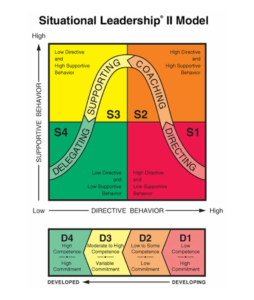Mastering Leadership in Banking: The Power of Situational Leadership
*This blog is based on the Performance Management class led by Laura Shreaves.
Effective leadership is the key to driving success in the dynamic and competitive banking world. As a manager in the banking industry, you play a vital role in guiding and inspiring your team to achieve exceptional results. The Situational Leadership Model is one leadership model that can empower you to adapt to various situations and maximize team performance. We will explore the four leadership styles within this model – directing, coaching, supporting, and delegating – and how you can apply them in banking management.
Directing Leadership Style
When team members are new or inexperienced, the directing leadership style is most appropriate. As a bank manager, you provide clear instructions and specific guidance and closely supervise their work. You help your team members understand their roles and responsibilities by establishing clear expectations and outlining the necessary steps. This style enables you to provide structure and support as your team members learn and grow in their roles.
Coaching Leadership Style
Coaching leadership is beneficial when team members have some level of competence but still require guidance and support. As a coach, you foster open communication, actively listen to your team members, and ask thought-provoking questions to stimulate their critical thinking and problem-solving skills. You empower your team members to develop their capabilities and overcome challenges by providing feedback, offering suggestions, and sharing your expertise. The coaching style encourages continuous learning and enhances the potential for growth within your team.
Supporting Leadership Style
The supporting leadership style suits team members who possess the necessary skills and experience but may need more confidence or face specific challenges. As a supportive leader, you provide encouragement, build trust, and create a safe environment for your team members to express their ideas and concerns. You offer guidance and resources while empowering them to take ownership of their work. Demonstrating your belief in their abilities and fostering a supportive atmosphere motivates your team members to excel and contribute their best to the organization.
Delegating Leadership Style
The delegating leadership style is most effective when team members are highly competent, experienced, and self-motivated. As a delegating leader, you trust your team members’ expertise and decision-making capabilities. You give them autonomy and empower them to take ownership of their tasks and projects. By stepping back and allowing your team members to showcase their abilities, you create an environment that encourages initiative, innovation, and accountability. The delegating style promotes efficiency, frees up your time for strategic planning, and fosters a culture of autonomy and self-reliance within your team.
Benefits of Situational Leadership in Banking Management
Adopting the situational leadership model in banking management can yield several benefits:
- Flexibility: Adapting your leadership style based on individual and situational needs allows you to address various challenges and capitalize on opportunities effectively.
- Team Engagement: By tailoring your leadership approach to meet the specific needs of your team members, you foster engagement, motivation, and a sense of purpose within your team.
- Improved Performance: The Situational Leadership Model enables you to provide appropriate support, guidance, and autonomy to optimize performance and achieve exceptional results.
- Personal Growth: By employing different leadership styles, you encourage continuous learning and professional development within your team members, leading to their personal growth and career advancement.
In the ever-evolving banking world, effective leadership is essential for driving success. The Situational Leadership Model offers a valuable framework for bankers in management, allowing them to adapt their leadership style to meet the unique needs of their team members. You empower your team by leveraging the directing, coaching, supporting, and delegating leadership styles.


